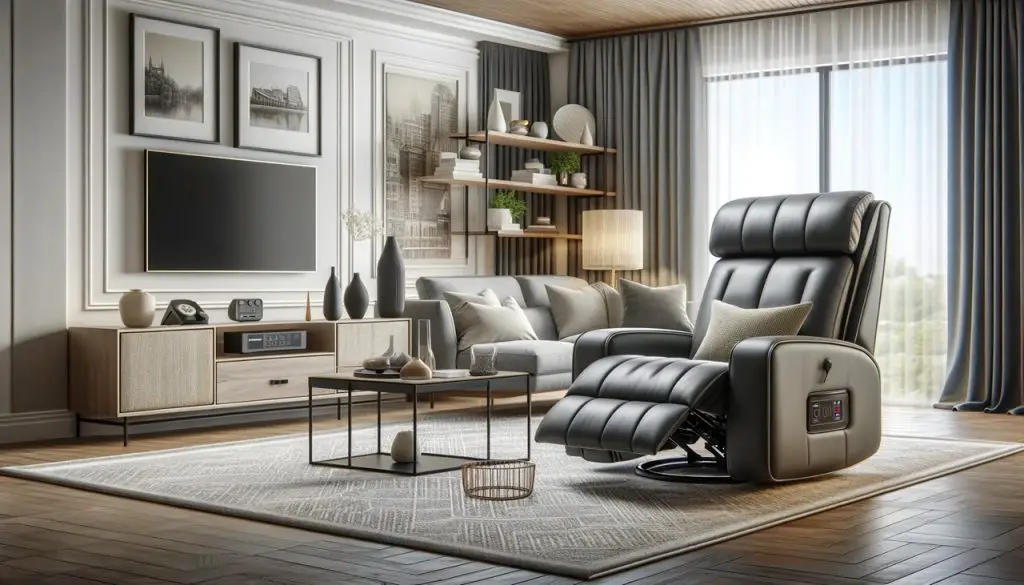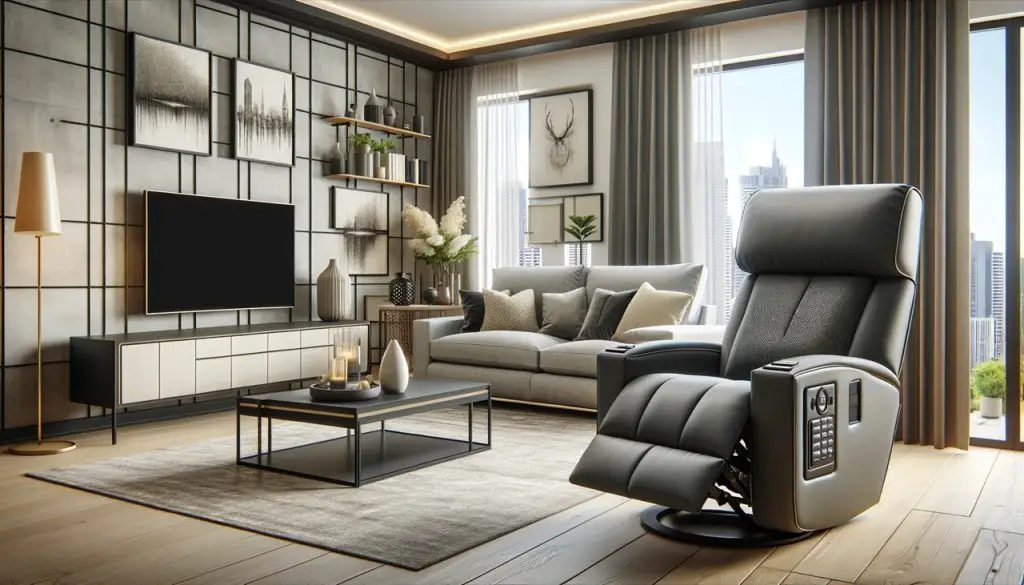How are recliners powered? Recliners have evolved from manual to electronically powered marvels, providing ease and relaxation to homes worldwide.
This article will guide you through understanding how these modern comforts work, ensuring that even if you’re a novice, you’ll have all the information you need.

Understanding the Basics of Recliner Power Sources
Embarking on the journey to comprehend the fundamentals of your recliner’s power source is the first step toward a seamless operation and long-term enjoyment.
Powered recliners, in their essence, are designed to provide you with a smooth transition from sitting upright to reclining in comfort, all without the need for manual adjustment. They achieve this ease of use through either an electrical connection or a battery-powered mechanism.
Electrically powered recliners require a nearby outlet to plug into, drawing power directly from your home’s electrical system.
This setup is ideal for those who have a permanent spot for their chair and don’t mind a cord running along the floor. These models tend to offer continuous power without the need for recharging, ensuring your chair is always ready for use.
On the other hand, battery-operated recliners offer more flexibility in placement since they’re not tethered to a wall outlet. They’re perfect for those who prefer a cleaner look without cords or who like to rearrange their furniture often.
While they do provide the convenience of portability, they also necessitate periodic recharging or battery replacement, which is an important consideration in terms of maintenance and cost.
Inside the recliner, regardless of the power source, lies the motor, which is the heart of the powered recliner. This motor is what allows you to recline and raise the chair with ease. With a simple push of a button, the motor activates and moves the chair into the desired position.
Some recliners have single motors that control both the footrest and backrest, while others have dual motors that allow for independent control of these two components, offering an extra level of customization for your comfort.
Step 1: Identifying Your Recliner’s Power Source
To begin, it’s essential to find out where your recliner gets its power from. This will typically be either from a power cord or a battery pack. Start by inspecting your recliner for any cords.
If your recliner is electric, you should find a power cord extending from the back or the underside of the chair.
Follow the cord to ensure it’s connected to a reliable power outlet. It’s important that the connection isn’t loose, as a secure plug ensures a consistent power supply to your chair.
If your recliner operates on a battery pack, you will usually find this pack located in the base of the chair. Check to see if it’s properly seated in its compartment.
If your recliner isn’t working and you’ve confirmed the outlet is operational, the battery pack may need recharging or replacing.
For those with removable battery packs, remove the pack and charge it according to the manufacturer’s instructions. If your battery is not removable, the chair will need to be positioned near an outlet to charge directly.
In both scenarios, confirm that there are no frayed wires or signs of wear and tear on the cord or battery pack, as these can be safety hazards.
Always refer to the manufacturer’s guide for specific details and safety warnings related to your particular recliner model.
By ensuring your recliner’s power source is correctly identified and maintained, you’re setting the stage for a reliable and relaxing experience in your reclining chair.
Step 2: Operating Your Powered Recliner
Operating a powered recliner is designed to be straightforward and stress-free. If your recliner comes with a remote control, it will typically be tethered to the chair or come as a separate wireless unit.
Familiarize yourself with the remote’s buttons, which usually include labels such as ‘recline’ and ‘lift’ or sometimes icons indicating their function.
To recline, gently press and hold the ‘recline’ button; your chair will smoothly move backward into the desired position. You can release the button at any point to stop the motion.
Should your recliner have buttons on its side, these are usually within arm’s reach and intuitively designed for ease of use. Press and hold the designated recline button to move the chair backward.
To bring your chair back to the upright position, use the button labeled ‘up’ or ‘raise.’ Press and hold this button until the chair is back in its original position or at the angle that supports you best.
In either case, some recliners offer additional features like adjustable headrests, lumbar support, or even preset positions for your convenience.
These options, if available, will have their own buttons. It’s a good idea to experiment with these features while the chair is in an upright position to understand their range of motion. Remember, moving slowly and steadily is key to finding the perfect position for relaxation or support.
Always make sure nothing obstructs the recliner’s path and keep children and pets clear while making adjustments.
This ensures both safety and the longevity of your recliner’s mechanics. With these simple steps, you can fully enjoy the comfort and functionality of your powered recliner.
Step 3: Troubleshooting Common Power Issues
When your recliner isn’t responding as it should, it’s natural to feel a bit of concern. However, many power issues can be resolved with some basic troubleshooting.
Start with the simplest solution: checking your power source. Make sure the power cord is securely plugged into both the chair and a working wall outlet. It’s a quick but crucial step to rule out loose connections or a tripped circuit breaker as potential culprits.
If your recliner is battery-operated, ensure the battery pack is properly seated and holds a sufficient charge. Some battery packs have indicators that show the charge level.
If yours doesn’t, try charging the pack for a while and then retesting the chair. Battery packs do have a lifespan, and if the chair still isn’t working with a fully charged pack, it may be time to replace it.
Should the power source appear to be in good order, the next step is to take a look at the recliner’s manual. Most manuals have a troubleshooting section tailored to the model’s specific needs. This can provide guidance on common issues, such as unresponsive controls or unexpected stopping.
If the manual doesn’t resolve the problem, it’s time to reach out for help. Customer support is there for exactly this reason.
A phone call or email to the manufacturer’s support team can often provide the solution. They may suggest something you hadn’t thought of or confirm that a professional repair is needed.

Step 4: Maintaining Your Powered Recliner
Proper maintenance of your powered recliner can greatly extend its life and ensure it continues to provide the comfort and convenience you’ve come to enjoy.
Start with the power cords. Inspect them regularly for any fraying, cuts, or kinks, which can not only impair functionality but also pose a safety risk.
If you notice any damage, refrain from using the chair until the cord can be replaced by a professional. It’s also wise to ensure the cord is not trapped under the recliner or stretched to reach the outlet, as this can cause wear over time.
For recliners with battery packs, it’s important to keep the contacts free of dust and debris. Use a clean, dry cloth to wipe the contacts every few months.
This will help prevent build-up that can interfere with the power supply. Also, be mindful of the battery’s lifespan; most will require replacement after a certain period, which can be found in your owner’s manual.
Another key aspect of maintaining your recliner is being mindful of the electrical load on your outlets. Plugging too many devices into one outlet or extension cord can cause overheating and potentially trip your circuit breaker. It may even damage the motor of your recliner.
If possible, dedicate a single outlet to your recliner, and if you’re using a multi-outlet extension, make sure it’s a high-quality one with a surge protector.
This can help shield the recliner’s electrical components from power spikes and surges, which can be particularly useful in areas prone to electrical storms or unreliable power grids.
Lastly, if your recliner has moving parts or mechanisms that are exposed, keep them clean and free from obstructions.
Occasionally vacuum beneath and around the recliner to prevent dust, pet hair, or small items from getting into the mechanism, which can cause premature wear or failure.
By taking these proactive steps in maintaining your recliner, you’ll not only ensure its continued performance and safety but also enjoy the full range of its features without interruption. Regular care is the key to a lasting and satisfying experience with your powered recliner.
Contacting a Professional For Repairs
When it comes to more complex issues that go beyond basic troubleshooting and maintenance, it may be time to contact a professional for repairs. There’s no shame in seeking expert help; it’s a wise decision to protect the investment you’ve made in your comfort.
Look for a certified technician who has experience with your specific type of powered recliner. You can usually find recommendations in your recliner’s documentation or by contacting the manufacturer’s customer service.
Before the technician arrives, try to have a clear description of the problem and any troubleshooting steps you’ve already attempted. This information can save valuable time and help the repair person bring the right tools and parts to fix your recliner efficiently.
Keep in mind that regular maintenance can prevent many issues, but when wear and tear or mechanical failures occur, a professional’s expertise is invaluable.
It’s also a good practice to inquire about the repair process, potential costs, and warranties on the service provided.
A reputable technician will provide a transparent estimate and explain the work that needs to be done. Remember, by entrusting your recliner to a professional, you’re ensuring that the repair is done safely and effectively, maintaining the integrity and longevity of your chair.
Ultimately, while routine care can minimize the need for repairs, when you’re faced with a malfunction that’s beyond your skill set, calling in a professional is the most effective way to get your powered recliner back to its best state.
With their specialized knowledge and tools, they can handle issues that are too complex or risky for a layperson to tackle, ensuring that you can return to relaxing in your recliner with peace of mind.
For more articles on recliners, click here: Recliners: Your Ultimate Guide to Comfortable Living
Conclusion: How Are Recliners Powered?
In conclusion, understanding how your recliner is powered and how to operate it properly is crucial for maximizing its potential for comfort and relaxation.
From identifying the power source to regular maintenance, and troubleshooting common issues, each step is important to ensure your powered recliner serves you well for years to come.
Remember, while some problems can be solved with simple at-home troubleshooting, others require the expertise of a professional.
By following these guidelines, you can enjoy the full benefits of your recliner without unnecessary interruptions.
Whether you’re settling in for a movie night or a nap, taking good care of your recliner means it will always be ready to provide you with the comfort and support you need at the touch of a button.